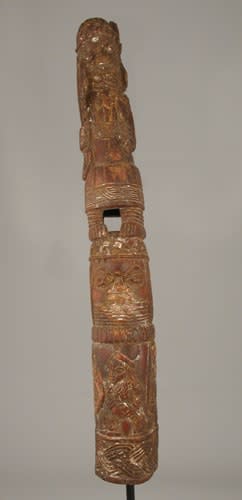Benin Ivory Totem, 1600 CE - 1897 CE
Ivory
2.5 x 18.25
PF.5543
The art of Benin is the product of an urban royal court, and is meant to symbolize and to extol the power, mystique, grandeur, continuity, and endurance of the ruling...
The art of Benin is the product of an urban royal court, and is meant to symbolize and to extol the power, mystique, grandeur, continuity, and endurance of the ruling dynasty. Benin was controlled by the Oba, a divine ruler at the head of the political system. As the office of the Oba became increasingly ceremonial and the art produced evolved into an instrument of the state, as seen in this work. The structure of the piece elegantly conforms to the cylindrical shape of the ivory tusk from which it was carved. One figure of an Oba stands upon another, suggesting his divine heredity and the continuity of his rulership with his ancestors. The Oba above bears several signs of his status. He holds a large sword in his right arm. He is bejeweled with coral necklaces, bracelets, and anklets that were only worn by the Oba. A coral or pearl headdress, merging with the hairdo, covers his head like a net. His face is depicted in the typical Benin courtly style, characterized by big open eyes and wide nostrils and lips. The king stands upon the head of a deceased Oba. Here, the face, similar to the one above, is framed by the headdress and coral necklaces. This truncated head sits upon a base carved with a band of four full-length figures which all wear elaborate costumes while a braided pattern decorates the frieze at the bottom of the piece. Undoubtedly, this work would have played an integral role in the royal ceremonies the Oba held to celebrate and fortify his standing. It would have been placed on a special altar further acknowledging its vital position. Both the form and the original function of this piece symbolize the rightful place of power that the Oba possessed.
